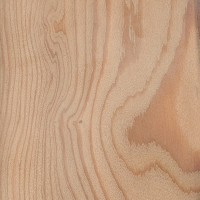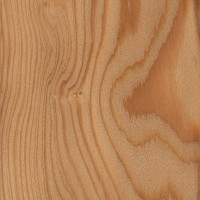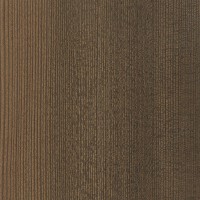 |
Common Name(s): European Larch, Common Larch Scientific Name: Larix decidua Distribution: Central Europe Tree Size: 85-150 ft (25-45 m) tall, 2-3 ft (.6-1 m) trunk diameter Average Dried Weight: 36 lbs/ft3 (575 kg/m3) Specific Gravity (Basic, 12% MC): .45, .58 Janka Hardness: 740 lbf (3,290 N) Modulus of Rupture: 13,050 lbf/in2 (90.0 MPa) Elastic Modulus: 1,711,000 lbf/in2 (11.80 GPa) Crushing Strength: 7,540 lbf/in2 (52.0 MPa) Shrinkage: Radial: 4.2%, Tangential: 8.2%, Volumetric: 12.5%, T/R Ratio: 2.0 |
Color/Appearance: Heartwood ranges from yellow to a medium reddish brown. Narrow sapwood is nearly white and is clearly demarcated from the heartwood. Flatsawn sections can exhibit a lot of character and interesting patterns in the growth rings. Knots are common but are usually small.
Grain/Texture: Grain is generally straight or spiraled. Texture is medium to fine with a greasy or oily feel.
Rot Resistance: Moderately durable regarding decay resistance.
Workability: Most hand and machine operations produce good results. However, natural resins in the wood have a tendency to gum up saw blades. Also, because of the disparity between the soft earlywood and the hard latewood, sanding can create dips and uneven surfaces.
Odor: European Larch can have a distinct resinous odor when being worked.
Allergies/Toxicity: Although severe reactions are quite uncommon, wood species in the Larix genus have been reported to cause skin irritation, as well as hives and skin lesions. See the articles Wood Allergies and Toxicity and Wood Dust Safety for more information.
Pricing/Availability: European Larch is harvested for construction lumber; prices should be moderate within its local range.
Sustainability: This wood species is not listed in the CITES Appendices, and is reported by the IUCN as being a species of least concern.
Common Uses: Veneer, utility poles, fence posts, flooring, boatbuilding, and construction lumber.
Comments: Even though European Larch is a conifer, it’s deciduous—it looses its leaves (needles) in the fall—and can have a pleasing growth form that somewhat resembles a branching gymnosperm. The trees are commonly planted as ornamental trees in Europe.
Ammonia fuming larch produces a darker colored wood surface; “fumed larch” veneer is sometimes used as a decorative veneer.
None available.
Scans/Pictures: A special thanks to Steve Earis for providing the wood sample (veneer) of this wood species.







What is the difference when using this for cladding as opposed to Siberian Larch (Larix Sibirica)?
Hi, our French supplier has recommended this for an outdoor decking. Any opinions? Thanks, Nick
Siberian larch is used extensively throughout Europe for outside decking. It has great resistance. It gets grey within one or two seasons though. I’ve seen wall cladding without any finish that looked grey and in bad condition, only to discover after cutting it that only the top layer was affected, and inside was perfectly fine timber.